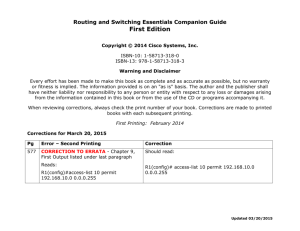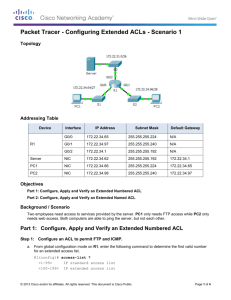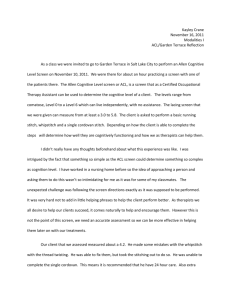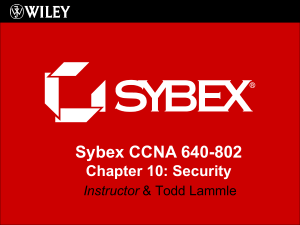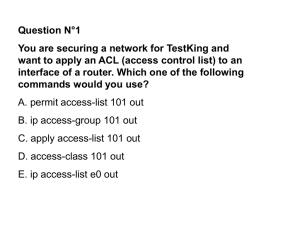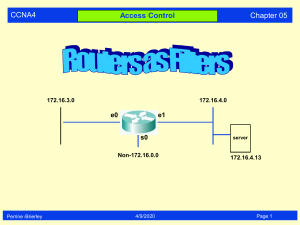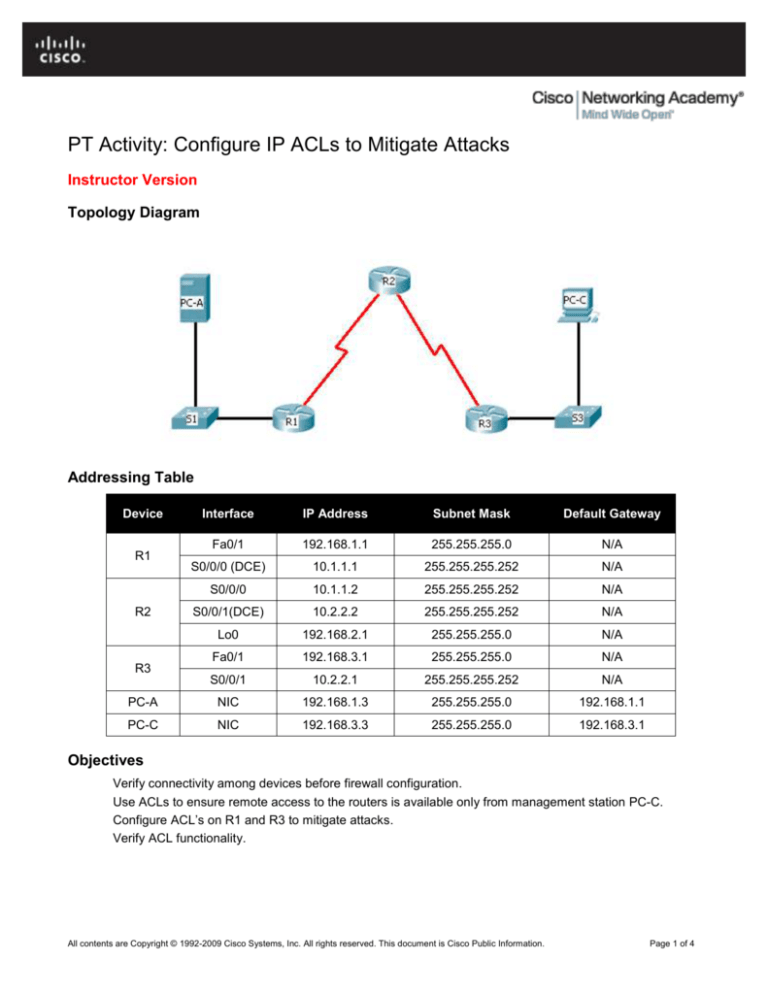
PT Activity: Configure IP ACLs to Mitigate Attacks
Instructor Version
Topology Diagram
Addressing Table
Device
Interface
IP Address
Subnet Mask
Default Gateway
Fa0/1
192.168.1.1
255.255.255.0
N/A
S0/0/0 (DCE)
10.1.1.1
255.255.255.252
N/A
S0/0/0
10.1.1.2
255.255.255.252
N/A
S0/0/1(DCE)
10.2.2.2
255.255.255.252
N/A
Lo0
192.168.2.1
255.255.255.0
N/A
Fa0/1
192.168.3.1
255.255.255.0
N/A
S0/0/1
10.2.2.1
255.255.255.252
N/A
PC-A
NIC
192.168.1.3
255.255.255.0
192.168.1.1
PC-C
NIC
192.168.3.3
255.255.255.0
192.168.3.1
R1
R2
R3
Objectives
Verify connectivity among devices before firewall configuration.
Use ACLs to ensure remote access to the routers is available only from management station PC-C.
Configure ACL’s on R1 and R3 to mitigate attacks.
Verify ACL functionality.
All contents are Copyright © 1992-2009 Cisco Systems, Inc. All rights reserved. This document is Cisco Public Information.
Page 1 of 4
CCNA Security
Introduction
Access to routers R1, R2, and R3 should only be permitted from PC-C, the management station. PC-C is also
used for connectivity testing to PC-A, a server providing DNS, SMTP, FTP, and HTTPS services.
Standard operating procedure is to apply ACL’s on edge routers to mitigate common threats based on source
and/or destination IP address. In this activity, you create ACL’s on edge routers R1 and R3 to achieve this goal.
You then verify ACL functionality from internal and external hosts.
The routers have been pre-configured with the following:
Enable password: ciscoenpa55
Password for console: ciscoconpa55
Username for VTY lines: SSHadmin
Password for VTY lines: ciscosshpa55
IP addressing
Static routing
Task 1:
Verify Basic Network Connectivity
Verify network connectivity prior to configuring the IP ACLs.
Step 1.
From the PC-C command prompt, ping the PC-A server.
Step 2.
From the PC-C command prompt, SSH to the router R2 Lo0 interface. Exit the SSH session.
Step 3.
From PC-C, open a web browser to the PC-A server to display the web page. Close the
browser on PC-C.
Step 4.
From the PC-A server command prompt, ping PC-C.
Task 2:
Step 1.
Secure Access to Routers
Configure ACL 10 to block all remote access to the routers except from PC-C.
Use the access-list command to create a numbered IP ACL on R1, R2, and R3.
R1(config)# access-list 10 permit 192.168.3.3 0.0.0.0
R2(config)# access-list 10 permit 192.168.3.3 0.0.0.0
R3(config)# access-list 10 permit 192.168.3.3 0.0.0.0
Step 2.
Apply ACL 10 to ingress traffic on the VTY lines.
Use the access-class command to apply the access list to incoming traffic on the VTY lines.
R1(config-line)# access-class 10 in
R2(config-line)# access-class 10 in
R3(config-line)# access-class 10 in
Step 3.
Verify exclusive access from management station PC-C.
SSH to 192.168.2.1 from PC-C (should be successful). SSH to 192.168.2.1 from PC-A (should fail).
PC> ssh –l SSHadmin 192.168.2.1
All contents are Copyright © 1992–2009 Cisco Systems, Inc. All rights reserved. This document is Cisco Public Information.
Page 2 of 4
CCNA Security
Task 3:
Create a Numbered IP ACL 100
On R3, block all packets containing the source IP address from the following pool of addresses: 127.0.0.0/8,
any RFC 1918 private addresses, and any IP multicast address.
Step 1.
Configure ACL 100 to block all specified traffic from the outside network.
You should also block traffic sourced from your own internal address space if it is not an RFC 1918 address (in
this activity, your internal address space is part of the private address space specified in RFC 1918).
Use the access-list command to create a numbered IP ACL.
R3(config)#
R3(config)#
R3(config)#
R3(config)#
R3(config)#
R3(config)#
Step 2.
access-list
access-list
access-list
access-list
access-list
access-list
100
100
100
100
100
100
deny ip 10.0.0.0 0.255.255.255 any
deny ip 172.16.0.0 0.15.255.255 any
deny ip 192.168.0.0 0.0.255.255 any
deny ip 127.0.0.0 0.255.255.255 any
deny ip 224.0.0.0 15.255.255.255 any
permit ip any any
Apply the ACL to interface Serial 0/0/1.
Use the ip access-group command to apply the access list to incoming traffic on interface Serial 0/0/1.
R3(config)# interface s0/0/1
R3(config-if)# ip access-group 100 in
Step 3.
Confirm that the specified traffic entering interface Serial 0/0/1 is dropped.
From the PC-C command prompt, ping the PC-A server. The ICMP echo replies are blocked by the ACL since
they are sourced from the 192.168.0.0/16 address space.
Step 4.
Remove the ACL from interface Serial 0/0/1.
Remove the ACL. Otherwise, all traffic from the outside network (being addressed with private source IP
addresses) will be denied for the remainder.
Use the no ip access-group command to remove the access list from interface Serial 0/0/1.
R3(config)# interface s0/0/1
R3(config-if)# no ip access-group 100 in
Task 4:
Create a Numbered IP ACL 110
Deny all outbound packets with source address outside the range of internal IP addresses.
Step 1.
Configure ACL 110 to permit only traffic from the inside network.
Use the access-list command to create a numbered IP ACL.
R3(config)# access-list 110 permit ip 192.168.3.0 0.0.0.255 any
Step 2.
Apply the ACL to interface F0/1.
Use the ip access-group command to apply the access list to incoming traffic on interface F0/1.
R3(config)# interface fa0/1
R3(config-if)# ip access-group 110 in
All contents are Copyright © 1992–2009 Cisco Systems, Inc. All rights reserved. This document is Cisco Public Information.
Page 3 of 4
CCNA Security
Task 5:
Create a Numbered IP ACL 120
Permit any outside host to access DNS, SMTP, and FTP services on server PC-A, deny any outside host
access to HTTPS services on PC-A, and permit PC-C to access R1 via SSH.
Step 1.
Verify that PC-C can access the PC-A via HTTPS using the web browser.
Be sure to disable HTTP and enable HTTPS on server PC-A.
Step 2.
Configure ACL 120 to specifically permit and deny the specified traffic.
Use the access-list command to create a numbered IP ACL.
R1(config)#
R1(config)#
R1(config)#
R1(config)#
R1(config)#
22
Step 3.
access-list
access-list
access-list
access-list
access-list
120
120
120
120
120
permit udp any host 192.168.1.3 eq domain
permit tcp any host 192.168.1.3 eq smtp
permit tcp any host 192.168.1.3 eq ftp
deny tcp any host 192.168.1.3 eq 443
permit tcp host 192.168.3.3 host 10.1.1.1 eq
Apply the ACL to interface S0/0/0.
Use the ip access-group command to apply the access list to incoming traffic on interface S0/0/0.
R1(config)# interface s0/0/0
R1(config-if)# ip access-group 120 in
Step 4.
Task 6:
Verify that PC-C cannot access PC-A via HTTP using the web browser.
Modify An Existing ACL
Permit ICMP echo replies and destination unreachable messages from the outside network (relative to R1);
deny all other incoming ICMP packets.
Step 1.
Verify that PC-A cannot successfully ping the loopback interface on R2.
Step 2.
Modify ACL 120 to permit and deny the specified traffic.
Use the access-list command to create a numbered IP ACL.
R1(config)#
R1(config)#
R1(config)#
R1(config)#
access-list
access-list
access-list
access-list
120
120
120
120
permit icmp any any echo-reply
permit icmp any any unreachable
deny icmp any any
permit ip any any
Step 3.
Verify that PC-A can successfully ping the loopback interface on R2.
Step 4.
Check results.
Your completion percentage should be 100%. Click Check Results to see feedback and verification of which
required components have been completed.
All contents are Copyright © 1992–2009 Cisco Systems, Inc. All rights reserved. This document is Cisco Public Information.
Page 4 of 4

